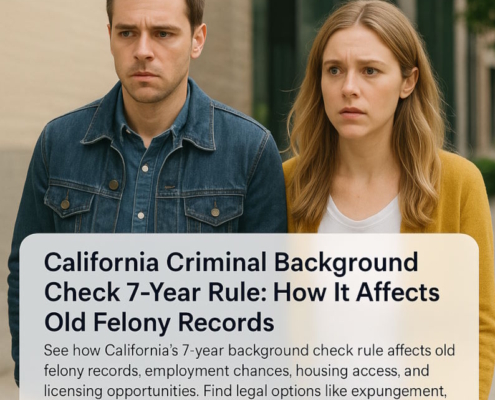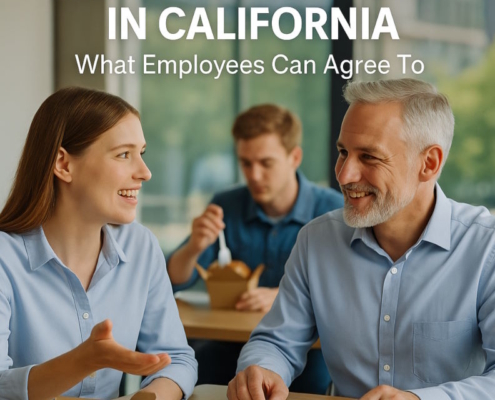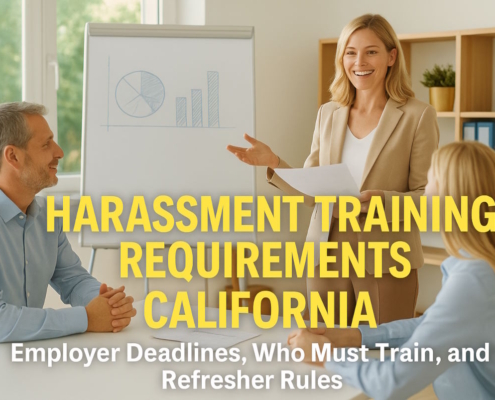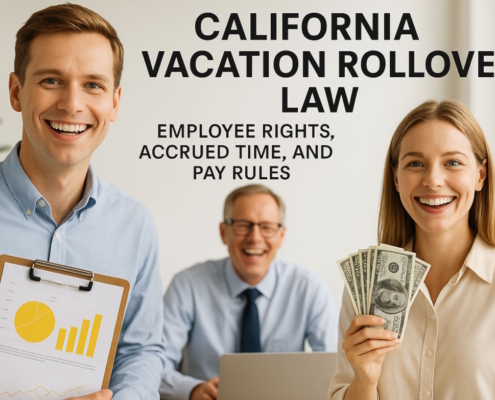What is Premium Pay?
Premium pay is an employee’s hourly rate (straight time rate) and nondiscretionary wages such as hiring bonuses, performance bonuses, working holidays, overtime pay, missed rest breaks, or missed lunch breaks.

By: Brad Nakase, Attorney
Email | Call (800) 484-4610
In California, premium pay is additional pay owed to an employee that is separate from the regular hourly pay. In California, employers must provide employees rest, meals, and recovery breaks. California employers that fail to provide their employees with uninterrupted rest, meals, or recovery breaks must pay employees premium pay. Premium pay is equal to one additional hour of pay.
In California, premium pay consists of a worker’s hourly rate, or straight time rate, in addition to nondiscretionary wages. These wages include attendance bonuses, incentive bonuses, hiring bonuses, and performance bonuses. Premium pay can therefore alter between pay periods because the worker’s discretionary pay might not always be consistent. Therefore, it is essential that an employee look carefully at their wage statements to make sure that they get their complete (and correct) premium pay for each of their missed break periods.
In this article, our attorney will discuss premium pay for:

What does premium pay mean for a job?
Under California law, an employer is required to provide rest, meal, and recovery breaks for his or her employees. If an employer does not supply these uninterrupted, code-compliant rest, meal, and recovery breaks, then he or she must give his or her works premium pay, or compensation. This means that if a worker believes they have been denied their rightful break periods in the workplace, they should contact an experienced employment lawyer to recover premium pay.
An employee can get premium pay for any of the following:
- Missed rest breaks
- Missed meal breaks
- Working overtime (8-12 hours)
- Working double time (over 12 hours per day or 7 consecutive days)
- Missed recovery breaks. Employees working outdoors are entitled to take a recovery break to prevent heat illness by cooling down.
- Incentive bonuses (only if company policy allows)
- Attendance bonuses (only if company policy allows)
- Performance bonuses (only if company policy allows)
- Hiring bonuses (only if company policy allows)
Example of Premium Pay for a job. An employee works 10 hours today. 8 of those hours is regular pay. 2 hours is overtime pay which is “premium pay.”
Rest Period Premium Pay
What is a rest period premium pay? Under California Labor Code section 226.7, if an employer does not provide an employee with an uninterrupted rest break, the employer must pay the employee a premium payment of one hour of pay at the employee’s regular hourly rate.
Example for Rest Break Premium Pay. An employee’s hourly rate is $20 per hour. The employee worked four hours and is entitled to a ten-minute break. The employee did not get the rest break. Therefore, the employer owes the employee a premium pay of $20 for the missed rest break. As a result, if the employee worked 5 hours, the employer owes the employee $20 X 5 hours + $20 for missed rest break = $120.
As a result, if a worker is denied a rest break, they may collect an hour of premium pay for that missed break period.
Meal Break Pay Premium
What is a meal break premium pay? Labor Code section 226.7 requires that if an employer fails to provide a meal break, the employer must pay the employee one hour of regular pay rate for each meal break not provided.
Example for Meal Break Premium Pay. . An employee’s hourly rate is $20 per hour. The employee worked five hours and is entitled to a meal break. The employee did not get the meal break. Therefore, the employer owes the employee a premium pay of $20 for the missed meal break. As a result, if the employee worked 8 hours, the employer owes the employee $20 X 8 hours + $20 for missed rest break = $180.
When an employer denies a California employee their meal break, the employee is entitled to meal break premium pay. This premium pay must consist of one additional hour of compensation paid at the regular rate for each kind of break that is not given. This means that if a worker is denied their lunch break, the employee may recover an hour of premium pay for that missed meal break.
Overtime Premium Pay
Employees who work more than 40 hours a week are entitled to a higher pay rate for the additional work. Overtime pay refers to the compensation you receive for working beyond normal working hours. Employers shall compensate employees at the premium rate of 1.5 times the regular rate of pay for hours worked which exceed 40 hours of actual work in a workweek. The formula for calculating overtime premium pay is the nonexempt employee’s regular rate of pay x 1.5 x overtime hours worked.
Example Overtime Premium Pay. Jane worked 8 hours today. When she was about to clock out to leave work, her supervisor asked Jane to stay two more hours. Therefore, Jane worked 8 regular hours and 10 overtime hours. Jane is entitled to 2 overtime premium pay.
What is straight time vs premium time?
Straight overtime is time worked that is more than an employee’s regularly scheduled hours, but less than 40 actual hours in a workweek. Straight time is compensated at the rate of one hour of pay per hour worked.Premium overtime is compensated at the rate of time-and-one half per hour.
Have a quick question? We answered nearly 2000 FAQs.
See all blogs: Business | Corporate | Employment
Most recent blogs:

Is Weight Discrimination Illegal in California? A Clear Look at Protections, Risks, and Employer Duties

Can I Refuse to Sign a Written Warning at Work?

Is Nepotism Illegal in California? What the Law Allows and Prohibits

Salary Requirements California: Minimum Pay, Exempt Status, and Overtime Rules

Borello Test Explained: Worker Classification Rules in California

California Criminal Background Check 7-Year Rule: How It Affects Old Felony Records

How to Get Your Guard Card in California: Training, Steps, and Requirements

Vacation Pay for Salaried Employees in California: Rights, Accrual Rules, and Payout Requirements

California Salary Threshold 2026: Minimum Wage Increase, Exempt Employee Rules, and Compliance Checklist

How Long Do Employers Have to Keep W-2s: Record Retention Rules for Businesses

PAGA Notice Statute of Limitations: California Deadlines for Filing Claims

California Class Action Lawsuit Basics for Workers and Consumers

Meal Break Waiver in California: What Employees Can Agree To

Predictive Scheduling Laws: State and City Requirements for Employers

Harassment Training Requirements California: Employer Deadlines, Who Must Train, and Refresher Rules

Inside Sales Exemption California: Rules on Pay, Breaks, and Commissions

How Many Hours Can a Volunteer Work per Day in California? Laws, Limits, and Rights Explained

Show Up Pay California: Employee Rights for Being Sent Home Early or Given Short Shifts

Can Managers Take Tips in California? Laws, Tip Pools & SB 648

Can Owners Take Tips in California? A Complete Guide to State Tip Laws and Employee Rights

Right to Disconnect Laws in California: AB 2751 for Employers and Employees

Defamation California: Key Laws, Legal Defenses, and Damages Explained

What Is a Level 1 Background Check and How It Differs from Level 2

California Vacation Rollover Law: Employee Rights, Accrued Time, and Pay Rules

SB 553 CA: New Workplace Violence Prevention Requirements for California Employers in 2025

Labor Code 226.7: California Meal and Rest Break Requirements and Employer Penalties

Building an Onboarding Packet That Welcomes and Retains Employees

Complete Guide to New Employee Paperwork: Required Forms and Documents for 2025

Paid Time Off California: Laws, Accrual, Vacation Pay, and Employee Rights

